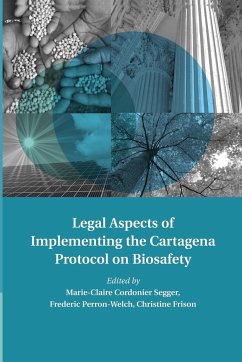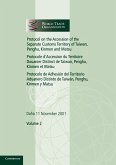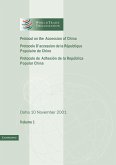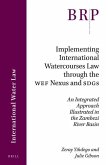Legal Aspects of Implementing the Cartagena Protocol on Biosafety
Herausgeber: Cordonier Segger, Marie-Claire; Frison, Christine; Perron-Welch, Frederic
Legal Aspects of Implementing the Cartagena Protocol on Biosafety
Herausgeber: Cordonier Segger, Marie-Claire; Frison, Christine; Perron-Welch, Frederic
- Broschiertes Buch
- Merkliste
- Auf die Merkliste
- Bewerten Bewerten
- Teilen
- Produkt teilen
- Produkterinnerung
- Produkterinnerung
This book, the first in a series that focuses on treaty implementation for sustainable development, examines key legal aspects of implementing the Cartagena Protocol on Biosafety to the UN Convention on Biological Diversity (CBD) at national and international levels. The volume provides a serious contribution to the current legal and political academic debates on biosafety by discussing key issues under the Cartagena Protocol on Biosafety that affect the further design of national and international law on biosafety, and analyzing progress in the development of domestic regulatory regimes for…mehr
Andere Kunden interessierten sich auch für
![Implementing Article 3 of the United Nations Convention on the Rights of the Child Implementing Article 3 of the United Nations Convention on the Rights of the Child]() Implementing Article 3 of the United Nations Convention on the Rights of the Child48,99 €
Implementing Article 3 of the United Nations Convention on the Rights of the Child48,99 €![Protocol on the Accession of the Separate Customs Territory of Taiwan, Penghu, Kinmen and Matsu to the Marrakesh Agreement Establishing the World Trade Organization Protocol on the Accession of the Separate Customs Territory of Taiwan, Penghu, Kinmen and Matsu to the Marrakesh Agreement Establishing the World Trade Organization]() World Trade OrganizationProtocol on the Accession of the Separate Customs Territory of Taiwan, Penghu, Kinmen and Matsu to the Marrakesh Agreement Establishing the World Trade Organization254,99 €
World Trade OrganizationProtocol on the Accession of the Separate Customs Territory of Taiwan, Penghu, Kinmen and Matsu to the Marrakesh Agreement Establishing the World Trade Organization254,99 €![Protocol on the Accession of the People's Republic of China to the Marrakesh Agreement Establishing the World Trade Organization Protocol on the Accession of the People's Republic of China to the Marrakesh Agreement Establishing the World Trade Organization]() World Trade OrganizationProtocol on the Accession of the People's Republic of China to the Marrakesh Agreement Establishing the World Trade Organization285,99 €
World Trade OrganizationProtocol on the Accession of the People's Republic of China to the Marrakesh Agreement Establishing the World Trade Organization285,99 €![The Geneva Protocol The Geneva Protocol]() David Hunter MillerThe Geneva Protocol21,99 €
David Hunter MillerThe Geneva Protocol21,99 €![Implementing International Humanitarian Law Implementing International Humanitarian Law]() Yusuf AksarImplementing International Humanitarian Law64,99 €
Yusuf AksarImplementing International Humanitarian Law64,99 €![Implementing International Watercourses Law through the WEF Nexus and SDGs Implementing International Watercourses Law through the WEF Nexus and SDGs]() Zeray YihdegoImplementing International Watercourses Law through the WEF Nexus and SDGs85,99 €
Zeray YihdegoImplementing International Watercourses Law through the WEF Nexus and SDGs85,99 €![Moral Aspects of Legal Theory Moral Aspects of Legal Theory]() David LyonsMoral Aspects of Legal Theory59,99 €
David LyonsMoral Aspects of Legal Theory59,99 €-
-
-
This book, the first in a series that focuses on treaty implementation for sustainable development, examines key legal aspects of implementing the Cartagena Protocol on Biosafety to the UN Convention on Biological Diversity (CBD) at national and international levels. The volume provides a serious contribution to the current legal and political academic debates on biosafety by discussing key issues under the Cartagena Protocol on Biosafety that affect the further design of national and international law on biosafety, and analyzing progress in the development of domestic regulatory regimes for biosafety. In the year of the fifth UN Meeting of the Parties to the Cartagena Protocol on Biosafety, at the signature of a new Nagoya-Kuala Lumpur Protocol on Liability and Redress, this timely book examines developments in biosafety law and policy.
Produktdetails
- Produktdetails
- Verlag: Cambridge University Press
- Seitenzahl: 666
- Erscheinungstermin: 30. Mai 2014
- Englisch
- Abmessung: 229mm x 152mm x 35mm
- Gewicht: 949g
- ISBN-13: 9781107438545
- ISBN-10: 1107438543
- Artikelnr.: 41529203
- Herstellerkennzeichnung
- Libri GmbH
- Europaallee 1
- 36244 Bad Hersfeld
- gpsr@libri.de
- Verlag: Cambridge University Press
- Seitenzahl: 666
- Erscheinungstermin: 30. Mai 2014
- Englisch
- Abmessung: 229mm x 152mm x 35mm
- Gewicht: 949g
- ISBN-13: 9781107438545
- ISBN-10: 1107438543
- Artikelnr.: 41529203
- Herstellerkennzeichnung
- Libri GmbH
- Europaallee 1
- 36244 Bad Hersfeld
- gpsr@libri.de
Part I. Essentials of Biosafety and Sustainable Development Law: 1.
Biosafety, the Cartagena Protocol, and sustainable development Kathryn
Garforth, Worku Damena Yifru and Mai Fujii; 2. Implementing sustainable
development through national biosafety frameworks Christine Frison,
Sylvestre-José-Tidiane Manga and Marie-Claire Cordonier Segger; 3. Crafting
national biosafety regulatory systems Gregory Jaffe; Part II. Sustainable
Development Law and Policy on Biosafety: 4. Risk assessment and risk
management Ryan Hill; 5. The decision-making procedures of the protocol
Worku Damena Yifru, Mai Fujii and Kathryn Garforth; 6. Handling, transport,
packaging and information Thomas Redick; 7. The question of public
participation Christine Toczeck Skarlatakis and Julian Kinderlerer; 8. The
biosafety clearing-house and sustainable development law Frederic
Perron-Welch; 9. Use of the biosafety clearing house in practice Tomme
Rosanne Young; 10. Socio-economics, biosafety and sustainable development
Frederic Perron-Welch; 11. The compliance mechanism: development, adoption,
content and first years of life Veit Koester; 12. Biosafety, liability and
sustainable development Frederic Perron-Welch and Olivier Rukundo; Part
III. National Implementation of Biosafety Regulatory Aspects: 13.
Legislative options for national implementation Tomme Rosanne Young; 14.
National biosafety regulatory systems in Central and Eastern Europe David
Duthie and Liina Eek; 15. Implementing the Cartagena Protocol in West
Africa: national and regional activities Gregory Jaffe and Papa Meissa
Dieng; 16. Comparative analysis of the national biosafety regulatory
systems in East Africa Gregory Jaffe; 17. The national biosafety regulatory
systems in Asian and Near East countries Nizar Mohamed; 18. The regulatory
and institutional biosafety systems in the Americas Jorge Cabrera Medaglia;
19. National experiences with legislative implementation of the protocol
Tomme Rosanne Young; 20. The Costa Rican legal framework on agricultural
genetically modified organisms Jorge Cabrera Medaglia; 21. Innovations in
biosafety law in New Zealand Frederic Perron-Welch; 22. Liability and
redress in Canadian case law: Hoffman v. Monsanto Canada Inc. Kathryn
Garforth and Paige Ainslie; 23. The use of GMOs in Chile and the protection
of indigenous culture Konstantia Koutouki and Paula Honorato Marin; Part V.
Global Policy Trends in Biosafety: 24. Sustainable development, biosafety
and international law Frederic Perron-Welch, Marie-Claire Cordonier Segger,
Christine Frison and Jorge Cabrera Medaglia; 25. Trade and investment
implications of implementing the Cartagena Protocol Marie-Claire Cordonier
Segger and Markus Gehring; 26. The Cartagena Protocol and the regulation of
genetically modified food aid Martin Endicot.
Biosafety, the Cartagena Protocol, and sustainable development Kathryn
Garforth, Worku Damena Yifru and Mai Fujii; 2. Implementing sustainable
development through national biosafety frameworks Christine Frison,
Sylvestre-José-Tidiane Manga and Marie-Claire Cordonier Segger; 3. Crafting
national biosafety regulatory systems Gregory Jaffe; Part II. Sustainable
Development Law and Policy on Biosafety: 4. Risk assessment and risk
management Ryan Hill; 5. The decision-making procedures of the protocol
Worku Damena Yifru, Mai Fujii and Kathryn Garforth; 6. Handling, transport,
packaging and information Thomas Redick; 7. The question of public
participation Christine Toczeck Skarlatakis and Julian Kinderlerer; 8. The
biosafety clearing-house and sustainable development law Frederic
Perron-Welch; 9. Use of the biosafety clearing house in practice Tomme
Rosanne Young; 10. Socio-economics, biosafety and sustainable development
Frederic Perron-Welch; 11. The compliance mechanism: development, adoption,
content and first years of life Veit Koester; 12. Biosafety, liability and
sustainable development Frederic Perron-Welch and Olivier Rukundo; Part
III. National Implementation of Biosafety Regulatory Aspects: 13.
Legislative options for national implementation Tomme Rosanne Young; 14.
National biosafety regulatory systems in Central and Eastern Europe David
Duthie and Liina Eek; 15. Implementing the Cartagena Protocol in West
Africa: national and regional activities Gregory Jaffe and Papa Meissa
Dieng; 16. Comparative analysis of the national biosafety regulatory
systems in East Africa Gregory Jaffe; 17. The national biosafety regulatory
systems in Asian and Near East countries Nizar Mohamed; 18. The regulatory
and institutional biosafety systems in the Americas Jorge Cabrera Medaglia;
19. National experiences with legislative implementation of the protocol
Tomme Rosanne Young; 20. The Costa Rican legal framework on agricultural
genetically modified organisms Jorge Cabrera Medaglia; 21. Innovations in
biosafety law in New Zealand Frederic Perron-Welch; 22. Liability and
redress in Canadian case law: Hoffman v. Monsanto Canada Inc. Kathryn
Garforth and Paige Ainslie; 23. The use of GMOs in Chile and the protection
of indigenous culture Konstantia Koutouki and Paula Honorato Marin; Part V.
Global Policy Trends in Biosafety: 24. Sustainable development, biosafety
and international law Frederic Perron-Welch, Marie-Claire Cordonier Segger,
Christine Frison and Jorge Cabrera Medaglia; 25. Trade and investment
implications of implementing the Cartagena Protocol Marie-Claire Cordonier
Segger and Markus Gehring; 26. The Cartagena Protocol and the regulation of
genetically modified food aid Martin Endicot.
Part I. Essentials of Biosafety and Sustainable Development Law: 1.
Biosafety, the Cartagena Protocol, and sustainable development Kathryn
Garforth, Worku Damena Yifru and Mai Fujii; 2. Implementing sustainable
development through national biosafety frameworks Christine Frison,
Sylvestre-José-Tidiane Manga and Marie-Claire Cordonier Segger; 3. Crafting
national biosafety regulatory systems Gregory Jaffe; Part II. Sustainable
Development Law and Policy on Biosafety: 4. Risk assessment and risk
management Ryan Hill; 5. The decision-making procedures of the protocol
Worku Damena Yifru, Mai Fujii and Kathryn Garforth; 6. Handling, transport,
packaging and information Thomas Redick; 7. The question of public
participation Christine Toczeck Skarlatakis and Julian Kinderlerer; 8. The
biosafety clearing-house and sustainable development law Frederic
Perron-Welch; 9. Use of the biosafety clearing house in practice Tomme
Rosanne Young; 10. Socio-economics, biosafety and sustainable development
Frederic Perron-Welch; 11. The compliance mechanism: development, adoption,
content and first years of life Veit Koester; 12. Biosafety, liability and
sustainable development Frederic Perron-Welch and Olivier Rukundo; Part
III. National Implementation of Biosafety Regulatory Aspects: 13.
Legislative options for national implementation Tomme Rosanne Young; 14.
National biosafety regulatory systems in Central and Eastern Europe David
Duthie and Liina Eek; 15. Implementing the Cartagena Protocol in West
Africa: national and regional activities Gregory Jaffe and Papa Meissa
Dieng; 16. Comparative analysis of the national biosafety regulatory
systems in East Africa Gregory Jaffe; 17. The national biosafety regulatory
systems in Asian and Near East countries Nizar Mohamed; 18. The regulatory
and institutional biosafety systems in the Americas Jorge Cabrera Medaglia;
19. National experiences with legislative implementation of the protocol
Tomme Rosanne Young; 20. The Costa Rican legal framework on agricultural
genetically modified organisms Jorge Cabrera Medaglia; 21. Innovations in
biosafety law in New Zealand Frederic Perron-Welch; 22. Liability and
redress in Canadian case law: Hoffman v. Monsanto Canada Inc. Kathryn
Garforth and Paige Ainslie; 23. The use of GMOs in Chile and the protection
of indigenous culture Konstantia Koutouki and Paula Honorato Marin; Part V.
Global Policy Trends in Biosafety: 24. Sustainable development, biosafety
and international law Frederic Perron-Welch, Marie-Claire Cordonier Segger,
Christine Frison and Jorge Cabrera Medaglia; 25. Trade and investment
implications of implementing the Cartagena Protocol Marie-Claire Cordonier
Segger and Markus Gehring; 26. The Cartagena Protocol and the regulation of
genetically modified food aid Martin Endicot.
Biosafety, the Cartagena Protocol, and sustainable development Kathryn
Garforth, Worku Damena Yifru and Mai Fujii; 2. Implementing sustainable
development through national biosafety frameworks Christine Frison,
Sylvestre-José-Tidiane Manga and Marie-Claire Cordonier Segger; 3. Crafting
national biosafety regulatory systems Gregory Jaffe; Part II. Sustainable
Development Law and Policy on Biosafety: 4. Risk assessment and risk
management Ryan Hill; 5. The decision-making procedures of the protocol
Worku Damena Yifru, Mai Fujii and Kathryn Garforth; 6. Handling, transport,
packaging and information Thomas Redick; 7. The question of public
participation Christine Toczeck Skarlatakis and Julian Kinderlerer; 8. The
biosafety clearing-house and sustainable development law Frederic
Perron-Welch; 9. Use of the biosafety clearing house in practice Tomme
Rosanne Young; 10. Socio-economics, biosafety and sustainable development
Frederic Perron-Welch; 11. The compliance mechanism: development, adoption,
content and first years of life Veit Koester; 12. Biosafety, liability and
sustainable development Frederic Perron-Welch and Olivier Rukundo; Part
III. National Implementation of Biosafety Regulatory Aspects: 13.
Legislative options for national implementation Tomme Rosanne Young; 14.
National biosafety regulatory systems in Central and Eastern Europe David
Duthie and Liina Eek; 15. Implementing the Cartagena Protocol in West
Africa: national and regional activities Gregory Jaffe and Papa Meissa
Dieng; 16. Comparative analysis of the national biosafety regulatory
systems in East Africa Gregory Jaffe; 17. The national biosafety regulatory
systems in Asian and Near East countries Nizar Mohamed; 18. The regulatory
and institutional biosafety systems in the Americas Jorge Cabrera Medaglia;
19. National experiences with legislative implementation of the protocol
Tomme Rosanne Young; 20. The Costa Rican legal framework on agricultural
genetically modified organisms Jorge Cabrera Medaglia; 21. Innovations in
biosafety law in New Zealand Frederic Perron-Welch; 22. Liability and
redress in Canadian case law: Hoffman v. Monsanto Canada Inc. Kathryn
Garforth and Paige Ainslie; 23. The use of GMOs in Chile and the protection
of indigenous culture Konstantia Koutouki and Paula Honorato Marin; Part V.
Global Policy Trends in Biosafety: 24. Sustainable development, biosafety
and international law Frederic Perron-Welch, Marie-Claire Cordonier Segger,
Christine Frison and Jorge Cabrera Medaglia; 25. Trade and investment
implications of implementing the Cartagena Protocol Marie-Claire Cordonier
Segger and Markus Gehring; 26. The Cartagena Protocol and the regulation of
genetically modified food aid Martin Endicot.









